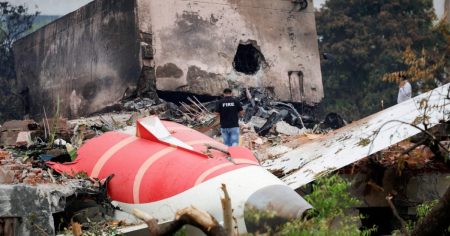A tense scene unfolded at Halifax Stanfield International Airport in Nova Scotia, Canada, on Saturday night as Air Canada Flight 2259, en route from Toronto to St. John’s, Newfoundland, experienced a harrowing emergency landing. The aircraft, carrying 73 passengers, encountered a critical malfunction with its landing gear, preventing the tires from deploying as it touched down on the runway. This resulted in the plane skidding along the tarmac, its fuselage grinding against the pavement, before ultimately coming to a halt engulfed in flames and smoke billowing from the left side.
The incident transpired amidst a backdrop of global aviation concerns, coinciding with a devastating plane crash in South Korea that claimed the lives of at least 167 people, marking the country’s worst aviation disaster. The stark contrast between the near-tragedy in Halifax and the catastrophe in South Korea underscored the unpredictable nature of air travel and the critical importance of robust safety protocols and rapid emergency response. While the South Korean incident resulted in significant loss of life, the events in Halifax, though terrifying, resulted in only minor injuries, a testament to the swift actions of the flight crew and emergency responders.
Nikki Valentine, a passenger aboard Flight 2259, recounted the terrifying moments of the emergency landing. As the plane approached the runway, it listed sharply to the left, accompanied by a loud crashing sound as the wing and engine scraped against the pavement. The impact caused the aircraft to tremble violently as fire erupted on the left side and smoke began to fill the cabin. Despite the chaotic scene, Ms. Valentine described an “organized hurry” as passengers evacuated the burning plane, highlighting the remarkable composure maintained amidst the unfolding emergency.
The swift evacuation, taking approximately two minutes, was a crucial factor in minimizing injuries. Passengers were quickly ushered onto a waiting bus and transported away from the burning aircraft, ensuring their safety and allowing emergency crews to focus on containing the fire. The organized evacuation, coupled with the rapid response of airport personnel and paramedics, likely prevented a far more tragic outcome. The incident served as a real-world example of the importance of effective emergency procedures and the crucial role of passenger composure in such situations.
Air Canada spokesperson Peter Fitzpatrick confirmed that the flight experienced a “suspected landing gear issue,” emphasizing that none of the passengers sustained serious injuries. This statement corroborated passenger accounts and underscored the effectiveness of the emergency response. The Royal Canadian Mounted Police (RCMP) in Nova Scotia, which responded to the scene along with paramedics, also reported only minor injuries, further reinforcing the positive outcome given the severity of the incident. The swift response and coordination between various emergency services played a crucial role in mitigating the potential for more severe injuries or fatalities.
The incident temporarily disrupted operations at Halifax Stanfield International Airport, with one runway closed to facilitate emergency response and subsequent investigations. The runway was later reopened, signifying a return to normal operations. The temporary closure highlights the airport’s commitment to safety and the importance of thoroughly assessing the situation before resuming normal activities. The incident, though disruptive, ultimately served as a testament to the airport’s emergency preparedness and the resilience of its operations. The rapid response and effective management of the situation minimized the impact on overall airport operations and ensured the safety of subsequent flights.











